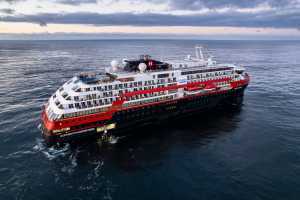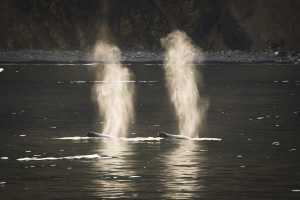The inflatable zodiac bobs languidly on a smooth, mercurial sea as I lower a white disc over the side of the boat and watch it slowly disappear into the depths. A curious seal surfaces to take a closer look as environmental scientist Dr Sonja Storm leans over to scoop up a jar of water, labelling it with the date and location.
It’s the middle of August, and we’re in sight of Murray Island, a remote outpost in the Northwest Passage (NWP): one of the world’s most epic and challenging sea routes across the Canadian Archipelago, which connects the Atlantic and Pacific via the mighty Arctic Ocean. Together with a handful of other sailors on board the HX expedition cruise ship, the MS Fridtjof Nansen, I’m helping Science & Education Coordinator Sonja with the Secchi Disk Study; a citizen science project which is investigating how climate change is impacting phytoplankton communities around the world.
“Not many ships sail these waters, so the daily data we collect here is genuinely contributing to vital scientific climate and marine research,” she says, recording the depth when the disc disappears, a simple technique which can help to determine the density of phytoplankton in the ocean. Similar to terrestrial plants, these microscopic algae use the process of photosynthesis to grow and play a vital role in regulating our climate, consuming around 100 million tonnes of CO2 every day and producing 50% of the oxygen we breathe. But in the past 50 years, phytoplankton has declined by 40%, which many scientists believe is due to rising ocean temperatures driven by climate change.
“Our guests enjoy getting out on the ocean and observing the plankton in the water samples they collect through the microscopes in our onboard Science Centre,” observes Sonja. “But in addition to the fun of seeing these alien-like lifeforms close up, our findings are also informing scientific understanding of the impacts of a warming world.”

The MS Fridtjof Nansen
Espen Mills
Formerly known as Hurtigruten Expeditions, HX offers Grand Expedition Cruises from pole to pole, lasting between 23 and 97 days, with the option to stay on board for up to a month exploring the destinations in between, from Greenland to Central or South America and the Atlantic Islands. My 27-day ‘In the Wake of the Great Explorers’ voyage is a sign in itself that our planet’s polar regions are changing.
Boarding in Iceland’s capital city, Reykjavik, the Fridtjof Nansen crosses the Denmark Strait to the dramatic fjords of southern Greenland, winds through the labyrinthine Northwest Passage, and terminates in Alaska’s gold-rush city of Nome on the Bering Sea.
While Inuit people have survived and thrived in this challenging icy realm for thousands of years, European explorers began searching for a shorter trading route between Asia and North America in the fifteenth century. This search claimed many ships and lives until finally Norwegian polar legend Roald Amundsen successfully led the first expedition on his ship, the Gjoa, between 1903 and 1906.
Thick sea ice prevented commercial cruise lines from attempting the NWP until the first expedition ship was able to pass through in the mid-1980s, but as the summer ice in the Arctic decreases, more expedition operators are venturing in. At the time of my sailing, the Fridtjof Nansen is the 75th cruise vessel to complete the journey, which can only be made between July and September. On my August cruise, ice is conspicuously absent, bar the odd rogue iceberg drifting by like a glistening ghost ship.

A pair of whales surfacing
Kim Rormark
“The Arctic’s summer sea ice has been decreasing each decade, with record lows in 2012 and 2020,” explains glaciologist Laura Gledhill during one of the many educational sessions hosted by the Nansen’s diverse expedition team. “Predictions indicate that the Arctic Ocean could potentially see a completely ice-free September as early as the 2030s, which will speed up warming in the polar region, weaken the Gulf Stream and impact the wildlife and indigenous communities that call the Arctic home.”
In this climatically harsh but environmentally fragile part of the world, our footprint matters more than ever: the Arctic is warming almost four times faster than the rest of the planet. “When I was a kid, there was lots of ice and the winter lasted longer. Today, winters are short and the ice melts much faster,” reveals Gibson Kelly Porter or ‘Gibby’, one of HX’s indigenous cultural interpreters, who join the cruise to share their personal stories, welcome us into their own remote communities along the NWP, and offer their perspectives on life in the Arctic.
Hailing from the coastal town of Gjoa Haven in Canadian Nunavut, 27-year-old Gibby balances the beliefs and traditions of his elders with the pressures of modern society – a difficult task that climate change will make even more challenging.
A whale's fluke
Kim Rormark
“It’s very expensive to buy things from the few stores we have here, as everything is shipped in just a couple of times a year or flown in, so local people throughout the NWP still rely on the ice for hunting native animals like beluga whales and seals for survival,” he explains, as we walk around the hamlet of Gjoa Haven. “In the olden days we would eat every part of the animal and would feed our dog teams, too. Now we use snowmobiles and quad bikes, and we leave some of the beluga whale meat behind for the polar bears to keep them fed and away from villages. They depend on the ice for hunting, just as we do.”
HX supports these remote communities with shore visits to experience indigenous culture including drum dancing, throat singing, printmaking and Arctic sports performances, along with storytelling and creative workshops on board. And, while the Nansen’s Scandi-chic Explorer Lounge, cabins and suites offer an abundance of space for some restorative R&R, and the spa, sauna, swimming pool, gym and hot tubs have guests’ pampering needs nailed, the voyage is really about discovering what happens in the wonderfully wild world beyond your balcony. Locals join the expedition team to talk honestly and openly about Arctic life, encouraging genuine connections and understanding. In Pond Inlet, Shelly Elverum joins the cruise to lead a session about Ikaarvik, a non-profit organisation she co-founded with some of her students at Nunavut Arctic College, where she taught environmental technology. Ikaarvik, which means “Bridge” in the local Inuktitut language, re-centres traditional indigenous knowledge systems into Western science and has trained hundreds of Inuit early-career scientists, including Gibby, in community-based research and engagement.
“We started Ikaarvik to reflect the goals of Inuit youth and give them an equal voice: young people wanted to make sure that the scientific research happening here makes sense to the local Inuit, not just to the visiting scientists and the government. The Inuit have a deep understanding of this environment and have survived because their ancestors thought like scientists. Inuit knowledge is not just an anecdote, a neat story or old-time knowledge: it is tried and tested science. The future of the north is on the shoulders of these young people.”

Kayaking along an arctic fjord
Kim Rormark
With diverse expedition teams comprising wide-ranging field experts of all ages from around the world, HX offers a culturally and environmentally sensitive deep dive into its cruise destinations, with on-board lecture programmes that cover topics including history, geology, ornithology, archaeology and conservation, and citizen science projects that include monitoring whale migration and recording cloud patterns for NASA. Still, the question has to be asked: with the impacts and consequences of climate change being felt so keenly in these remote polar regions, should cruise companies even be visiting at all?
“I realise some people may be questioning why I’m delivering a talk about climate change on a ship emitting CO2,” says Laura Gledhill as we chat on the outdoor Observation Deck while scouring the coastline for polar bears. “But by educating guests about the changes happening in the Arctic and the challenges the communities and wildlife are facing, I hope they’ll go home and make more thoughtful choices in their own lives. Travelling with a company that takes sustainability seriously and supports local initiatives and climate science can have an incredibly positive impact: sailors on HX’s expeditions return home as ambassadors for the polar regions.”
This year’s launch of Royal Caribbean’s behemoth, Icon of the Seas – the largest cruise vessel ever to set sail, with a capacity for 10,000 people on board – has once again put the environmental impact of cruising in the spotlight, from the emissions expelled by super-sized, fuel-guzzling ships, to the amount of waste they produce, and the chaotic deluge of passengers flooding into destinations when these floating amusement parks pull into port.

A muskox in Ivittitut, Greenland
Tommy Simonsen
A member of the Association of Arctic Expedition Cruise Operators (AECO), HX is leading the way in sustainable cruising, operating two of the world’s most environmentally friendly cruise ships: the electric-powered, lower-emission expedition vessels the MS Roald Amundsen, which launched in 2019, and the Fridtjof Nansen in 2020. Each carries just 530 passengers and arranges staggered shore landings and activities to minimise the impact of tourism on the local environment and people. The first cruise company to remove single-use plastics from all its ships in 2018, HX offers seasonal menus with plenty of vegetarian options and also donates thousands of berths to the scientific community, enabling them to conduct field studies in destinations that would otherwise be incredibly difficult and expensive to reach. On my sailing, a biologist from the conservation organisation ORCA is on board, recording whale sightings throughout the NWP from the bow.
“Cruising is a carbon-intensive industry, there is no getting away from that,” admits Tudor Morgan, HX’s VP of Sustainability & Industry Relations. “But HX was the first cruise line to ban heavy fuel oil (in 2009) and campaigns for its worldwide ban. To set a new standard, we are also considering a range of new, green fuel options, including biofuels made from organic waste. Regulation will change all cruise emissions in the medium-to-long term, but in the short term, expedition operators are responding more quickly, as the effects on the areas where we sail are very apparent and our guests are often more informed about the climate crisis and want to make a difference. Our goal is to be emission-free by 2050.”
A month spent living aboard a ship in a largely uncharted realm may seem daunting for some, but by the time we leave the Fridtjof Nansen in Alaska, she feels like home, and the memory of an extraordinary and unique shared experience endures. Perhaps the answer to the question we are all asking as we sail into an uncertain future isn’t whether we should be travelling at all but how we can make sure each journey matters.
